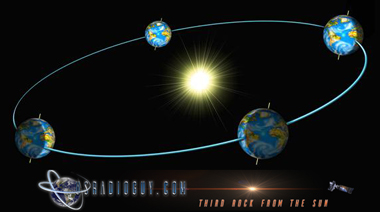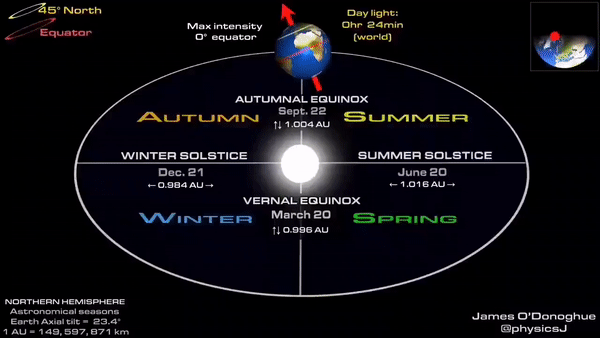![]()
The four seasons, namely spring, summer, fall, and winter, are part of the natural cycle of the Earth’s orbit around the sun. Each season is defined by a unique combination of astronomical and climatic factors, which affect weather patterns, animal behavior, plant growth, and human activities. The GOES-R Series satellites, operated by the National Oceanic and Atmospheric Administration (NOAA), provides a unique perspective of these seasonal changes from space, allowing us to better understand the dynamics and the rhythms of the Earth’s atmosphere.

The Earth has seasons because of its axial tilt and its orbit around the sun. The Earth’s axis of rotation is tilted at an angle of 23.5 degrees relative to its orbital plane. As the Earth revolves around the sun, different parts of the planet receive varying amounts of solar radiation at different times of the year. When the northern hemisphere is tilted towards the sun, it receives more direct sunlight and experiences longer periods of daylight, resulting in warmer temperatures and the onset of summer. Conversely, when the northern hemisphere is tilted away from the sun, it receives less direct sunlight and experiences shorter periods of daylight, resulting in colder temperatures and the onset of winter.

The Earth’s axial tilt also plays a role in the equinoxes, which mark the beginning of spring and fall. During the equinoxes, the tilt of the Earth’s axis is perpendicular to the sun’s rays, resulting in equal periods of daylight and darkness at all points on the planet. As the Earth continues to orbit the sun, the axial tilt gradually changes, leading to the onset of the different seasons. Without this axial tilt, the Earth would not experience any seasons, and the climate would be more uniform across the planet.
Spring:
Spring marks the beginning of the astronomical year when the Earth is positioned in such a way that the sun’s rays are directly hitting the equator. This results in an equal distribution of daylight and darkness, a phenomenon known as the vernal equinox. From the perspective of the GOES-16 satellite, the transition from winter to spring is characterized by a gradual increase in the amount of green vegetation on the ground, as dormant plants begin to sprout new leaves and buds. The satellite can also detect changes in atmospheric circulation patterns, as cold air masses retreat northward and warm air masses move in from the south.
Summer:
Summer is the season of longest days and shortest nights, as the Earth’s axis tilts towards the sun, and the northern hemisphere receives more direct sunlight. The resulting increase in solar radiation triggers a wide range of climatic and biological processes, from thunderstorms and hurricanes to blooming flowers and migrating birds. From the perspective of the GOES-16 satellite, the summer season is characterized by intense heating of the Earth’s surface, which leads to the formation of cumulus clouds and thunderstorms. The satellite can also monitor the movement of tropical storms and hurricanes, which often develop over warm ocean waters during the summer months.
Fall:
Fall, or autumn, is marked by the opposite astronomical phenomenon as spring – the autumnal equinox – when the Earth’s axis is again tilted away from the sun, resulting in shorter days and longer nights. This change triggers a cascade of biological processes, as plants prepare for the winter months by shedding leaves, fruits, and seeds. From the perspective of the GOES-16 satellite, the fall season is characterized by a gradual decrease in the amount of green vegetation, as trees and shrubs enter a period of dormancy. The satellite can also detect changes in atmospheric circulation patterns, as cold air masses from the north begin to move southward.
Winter:
Winter is the season of shortest days and longest nights, as the Earth’s axis is tilted furthest away from the sun, resulting in the least amount of direct sunlight. This leads to a period of dormancy for many plants and animals, as they conserve energy and wait for the return of spring. From the perspective of the GOES-16 satellite, the winter season is characterized by the formation of large-scale weather patterns, such as cold fronts, blizzards, and polar vortexes. The satellite can also monitor the movement of ice and snow cover on the ground, which plays an important role in regulating the Earth’s climate.
The four seasons – spring, summer, fall, and winter – are an integral part of the natural cycle of the Earth’s orbit around the sun. From the perspective of the GOES-16 satellite, these seasons are characterized by a wide range of astronomical and climatic phenomena, which affect the behavior of the Earth’s atmosphere, oceans, and biosphere. By studying these seasonal changes from space, we can gain a deeper understanding of the dynamics of our planet, and the impact of human activities on its delicate balance.
Special note to those in the Southern Hemisphere.
When Spring is starting in the Northern Hemisphere, Autumn is starting in the Southern Hemisphere. So in order to accurately reflect this fact please turn your computer or smartphone upside down and read this article backwards. Just kidding!!




